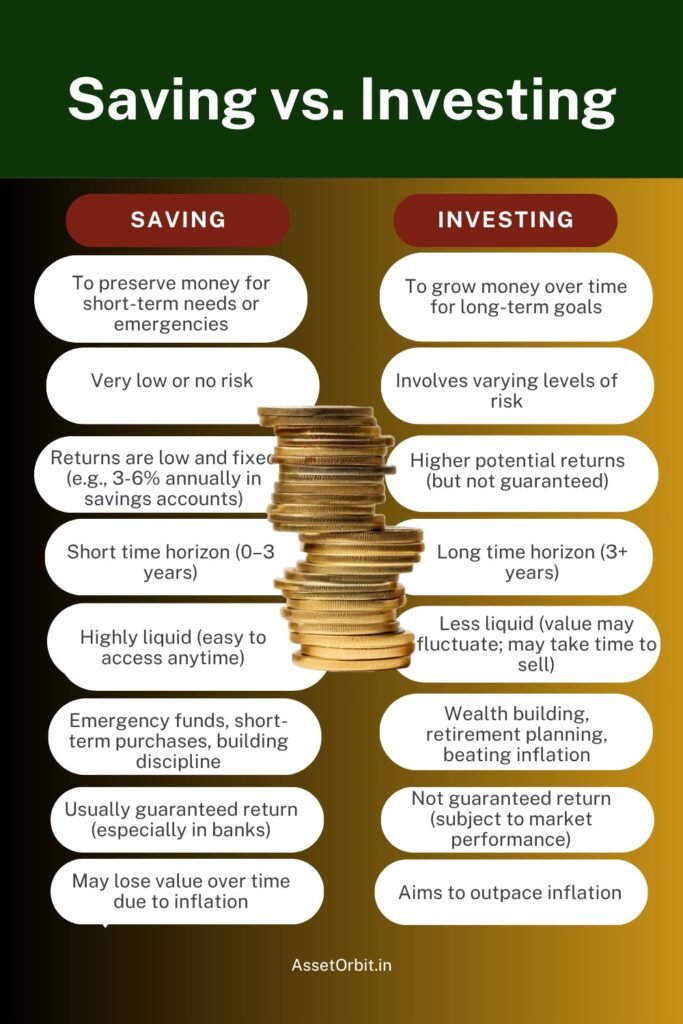If you want to be financially secure in the future, saving and investing are musts. Investing entails putting money into assets like stocks, bonds, or real estate, whereas saving entails keeping money in a safe account. You should save for immediate needs and invest for the future; both have their advantages and disadvantages.
In Short
When you consider your future finances, what ideas spring to mind? Many people start their journey by saving and investing. Some may ask, “Why am I supposed to begin at this time?”
This is because compound interest is most effective when initiated at an early age. Imagine a world where your money is always growing and never runs out.
I know what you’re thinking: “Isn’t investing risky?” You can save and invest with less uncertainty if you follow some proven strategies.
You may start your financial path with risk-free solutions, regardless of how much experience you have. You may achieve more financial freedom by mastering the art of compound interest.
Because of this, why not act now? If you want to build a safe and comfortable future for yourself, you need to start saving and investing now.
Saving and Investing
If you want to be financially secure in the future, you must know that saving is different from investing. Put your money in a secure, risk-free location, like a savings account, and you’ll be able to access it fast when you need it. That’s saving.
But investing is putting your money into things like stocks, bonds, or assets with the expectation that they will increase in value over time.
You might be wondering why each of these items is necessary at this point. This is because investing is a fantastic way to take advantage of proven strategies for building your wealth over a long period, while saving is ideal for times when you need cash quickly.
If you do both, you’ll have a worry-free financial future.

What Exactly is Saving?
Saving is a type of wealth accumulation. It entails putting some of your salary aside in a savings device, such as a bank account, for everyday expenses, emergencies, vacations, or purchasing a new smartphone. Savings are often low risk and very liquid. In other words, your money is safe in a savings account, and you can withdraw and deposit it whenever you want. However, any returns are minimal.
Benefits of Saving
- Aids in the management of basic expenses
- Aids in the construction of an emergency safety net
- Can be utilized to attain short-term goals
- Low risk and high liquidity
Cons of Saving
- Lower returns
- Inflation can eat into your savings
What Exactly is Investing?
Investing is a method of increasing the value of your money. It requires you to invest your money in financial assets such as stocks, mutual funds, real estate, bonds, and so on, which have the potential to yield better returns in the long run. However, bigger potential rewards come with more risk, which varies depending on the instrument. The primary distinction between saving and investing is that although saving helps with day-to-day expenses, short-term goals, and crises, investment is mostly focused on medium and long-term financial goals. People diversify their investments to try to lessen risk because investment items carry a higher amount of possible risk.
Advantages of Investing
- Potentially larger returns than saving Can be utilized to achieve medium to long-term goals
- Creating a diverse portfolio can assist in reducing risk
Cons of Investing
- Investments may result in losses, particularly in the near term
- Generally, longer terms are preferable
- Knowledge, patience, and discipline are required
Major Differences Between Saving and Investing
| Parameter | Saving | Investing |
| Meaning | Setting aside some portion of your income in a saving instrument | Putting your money in financial instruments for long-term growth |
| Ideal for | Everyday expenses, emergencies, short-term objectives | Medium to long-term financial goals |
| Liquidity | High | Generally not as liquid as saving instruments |
| Risk | Low risk | Higher risk |
| Returns | Generally lower | Potentially higher |
To effectively organize your finances, you must understand the distinctions between savings and investing. While both saves and investments are important in personal finance, the concepts are not interchangeable. You can make informed judgments about how to handle your finances if you understand their distinctions and how they interact.
How to Decide Whether to Save or Invest Money?
Your financial goals, time perspective, and risk tolerance all influence whether you save or invest your money. Here are some things to think about:
- Financial Objectives: If you have short-term goals, like as purchasing a new car or taking a trip, saving is the preferable alternative. Investing is better suited for long-term goals such as retirement.
- Time Horizon: Investing can help you increase your money and earn bigger profits if you have a longer time horizon. However, if you need money quickly, saving is the preferable alternative.
- Tolerance for Risk: Investing entails risk, and the value of your investments may fluctuate over time. Investing can be a fantastic alternative if you’re willing to take risks and have a lengthy investment horizon. However, if you desire stability over risk, saving is the preferable alternative.
Diversification is essential for risk management in investing. You can lower your risk of loss by diversifying your assets among asset types such as stocks, bonds, and mutual funds.
The Story of Warren Buffett’s First Investment—and Why He Didn’t Just Save
At the age of 11, Warren Buffett made his first investment by purchasing three shares of Cities Service Preferred stock for himself and his sister at $38 per share. Shortly after the purchase, the price fell to $27. He felt nervous but chose to hold on to the stock. Eventually, the price rose to $40, and young Buffett decided to sell in order to secure a small profit.
But shortly after he sold, the stock continued to rise, eventually reaching $200.
That early experience taught Buffett a valuable lesson about the importance of investing:
Patience and long-term investing are more effective than short-term thinking and basic saving.
Buffett didn’t store his money in a piggy bank or save it in a fixed deposit. Instead, he invested, and that practice became the foundation of his wealth. Today, he ranks among the richest individuals in the world, not by saving more, but by investing wisely.
Key takeaway
- Saving helps safeguard your money.
- Investing has the potential to grow your money.
Buffett’s story illustrates that to achieve long-term wealth, it is essential to invest your money rather than simply keeping it safe.
Final Thoughts
To attain your financial goals, it is best to have a mix of savings and investments. Begin by putting money aside in a high-yield savings account for an emergency fund that covers 3-6 months of living expenses. After that, you can begin investing in equities or mutual funds for long-term growth.
FAQ
Should you have more invested than saved?
The balance between savings and investments is crucial for long-term wealth growth, as investments can generate higher returns. However, the right proportion depends on an individual’s financial goals, time horizon, and risk tolerance. Maintaining an emergency fund through savings is essential for financial security. Striking the right balance, with a sufficient savings buffer for short-term needs and surplus funds for long-term growth, can create a well-rounded financial strategy. Diversification across savings and investments can mitigate risks and ensure a resilient financial portfolio.
When should I start investing?
Starting investing early is crucial for compounding returns and generating earnings over time. A stable financial foundation with an emergency fund and manageable debt is ideal. Investing with a modest amount allows time for growth. Understanding financial goals, risk tolerance, and strategy is essential. Seeking financial advice can help develop a tailored investment plan based on individual circumstances and objectives.













gate io
The point of view of your article has taught me a lot, and I already know how to improve the paper on gate.oi, thank you.